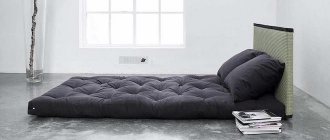Each nation has its own history, traditions, religion, customs and culture, which have developed over many centuries and influence all aspects of human life. There are differences even in terms of bedtime rules. So, in ancient times in Rus' people slept on stoves and blankets, and in Japan they slept on mats spread on the floor. The Japanese are famous for their excellent health, intelligence, restraint, wisdom, and high level of culture, therefore, today we will talk specifically about Japanese bedding, tatami, futon mattresses, what they are, how to use them, etc.
What are Japanese tatami and futons?
Wealthy Japanese, instead of straw mats, used tatami mats, which were woven from reeds and stuffed with rice straw. However, tatami was not comfortable and soft. There was a whole ritual and rules for their layout. It was believed that you could bring misfortune and misfortune upon yourself if you placed the mats in the wrong order. The number of tatami laid out also mattered. Even now they are used in Japanese homes.
In the seventeenth century, the futon mattress appeared in Japan, which is used throughout the world to this day. A futon is a traditional Japanese bed that is laid out at night and put away when you wake up in a secluded place. They were made from cotton fabric and stuffed with wool or cotton. These mattresses were beyond the means of ordinary Japanese. Only the most noble and wealthy people had futons. Such bedding was an excellent gift, including for winning a woman’s heart.
In the land of the rising sun, it is not customary to clutter up space, everything is very simple, a minimum of furniture and a maximum of free space. This approach to home improvement finds many adherents in different parts of the world. That is why futons and oriental style in interior design are so popular. A futon is used not only as a main sleeping place, but also as an additional place for guests to sleep, as a mattress for couches and folding beds, and you can cover a chair or bench with it. This product will help out at the dacha, in a country house and on vacation, because... it is lightweight, easy to transport and store.
Pros of sleeping on the floor
The height of a Japanese futon never exceeded 5 cm, but even this was a true luxury for samurai accustomed to Spartan conditions. Futons were expensive - about a million yen - so only noble and very rich gentlemen could afford them. And they didn’t build tiered beds in the spirit of the Princess and the Pea.
The Japanese have known since ancient times that sleeping on a solid base is good for the spine. On a soft bed, the back bends, the vertebrae put pressure on the discs, which leads to pinching and hernias. This does not happen if the bed is located on a hard base or directly on the floor.
Anyone who suffers from spinal diseases should learn from the experience of the Eastern brothers or purchase an orthopedic mattress from the Magic of Sleep store. The second option will be an adequate replacement for a futon: it will take care of your back and make your sleep enjoyable.
How to choose a futon
Choosing a futon mattress should not be spontaneous and thoughtless. In order for the product to be useful and to be able to use it at all, it is necessary:
- determine how and where you are going to use it. Perhaps you are going to sleep on the floor like a real Japanese samurai, spreading out a futon. Or you need a topper to put on a sofa or usual sleeping place. The topper will remove unevenness, soften or make the sleeping surface harder. Perhaps you need a futon just in case unexpected guests arrive and you need to accommodate them for the night.
- Decide what size futon mattress you need. To do this, you need to measure the sleeping area where you plan to lay the mattress, or measure the free space on the floor if you intend to sleep this way. The maximum size of a futon is 180 x 200 cm.
- decide on the thickness of the mattress. Typically, a futon has a thickness of 8 to 20 cm. The thinnest products (toppers) will hide the unevenness of an old sofa or mattress well, and also soften the hard covering. Thicker ones may well replace traditional mattresses.
- pay attention to the filler, which is most often used polyurethane foam or natural latex. The latest version of the filler is famous for its orthopedic properties, natural origin, high service life and wear resistance. A futon made of polyurethane foam is a good product for little money. The cover is sewn from natural cotton fabric - an environmentally friendly, hypoallergenic, easy-to-clean material.
- what type of futon do you need? A traditional Japanese mattress can be not only in the form of a solid rectangular sheet, but also in the form of a folding one (transformer). Transforming models turn from an ottoman or armchair into a full-fledged sleeping place. They do not need to be rolled up and stored on the mezzanine until they are needed again. For small-sized apartments, transformable objects are a godsend and an excellent solution.
- find out what the maximum weight the product is designed for. A standard futon can support a person weighing up to 110 kg.
- the need for additional devices in the form of Velcro, elastic bands, ties, with which the futon can be secured to a sofa, chair, bed, cot. These devices will prevent the mattress from sliding on the surface and will securely fix it.
What are the benefits of a Japanese futon?
The various ways to use a Japanese futon do not detract from its advantages. Whatever form it is used in (mattress, topper, sofa or chair), it remains comfortable and practical.
Traditional futons are made from only natural materials. In modern versions, there are many offers with artificial fillers, but they are of high quality. The materials used do not cause allergic reactions and, with proper care, have a long service life.
Storing a futon does not require much effort. Regular ventilation and lack of humidity (when using it in the traditional way - on the floor) will keep the product pleasantly airy for a long time.
Futon is easy to use, does not require special storage conditions, and is affordable.
By choosing a futon for your home, you get:
- comfortable sleeping place (it can be main or additional);
- a practical way to improve your existing sleeping space at a minimum cost;
- the opportunity to create an original interior.
Among the disadvantages of the product, the need to comply with storage and operating conditions should be highlighted. First of all, protect the product from moisture. In gratitude for good care, the futon will reward you with good sleep and a healthy spine.
Advantages
A futon is a very useful thing that justifies the money spent on the purchase. This product has enough advantages:
- space saving. If you are purchasing a futon as an extra bed, it can be easily rolled up and stored away. A transformable futon is indispensable in small apartments; in fact, it is a combination of an armchair or ottoman and a sleeping place.
- Wear resistance. Japanese mattresses are designed to weigh up to 110 kg, and they can last up to 8 years.
- The cover is made traditionally from cotton fabric - durable and natural.
- Filling made of latex and polyurethane foam has good orthopedic properties.
- Latex filling does not cause allergies, does not absorb moisture, dust and odors.
- Good breathability.
- No glue. The filler and the cover are connected without the use of glue. The connection occurs by stitching.
- Toppers (thin futons) work well to level out old dented, uneven surfaces.
- Easy care.
How to care for your futon
In order for a futon mattress to last as long as possible, you should take care of it, almost the same as any mattress:
- purchase a removable cover. Thanks to it, stains, dust and dirt are not harmful to the mattress. The cover is undoubtedly easier to wash than the mattress.
- Periodically, 2-3 times a month, vacuum the futon and ventilate it in the fresh air. Do not forget that natural latex filling is afraid of sunlight and high temperatures, so do not dry a natural latex futon in the sun.
- If stains occur on your futon mattress, remove them using a little soap and water or a solution of baking soda and water. Then dry thoroughly.
How they sleep in Japan: the history of the traditional Japanese bed
The Japanese did not always sleep on tatami beds. It is known that in the 13th century, most of the country's inhabitants could only afford hard mats stuffed with straw. Futon mattresses appeared only in the 17th century. They were much softer (after all, they were stuffed with cotton and wool), but they cost a lot of money. Therefore, only the wealthiest residents of the country slept on them.
Futons began to be used en masse in the 19th century, when, due to the cheapening of cotton, the price of products made from it also decreased significantly.
Photo from the 19th century - this is how the Japanese slept before the popularization of tatami
Tatami appeared in the 17th century, then they were hard mats made of igus (reed) and filled with rice straw. They covered the entire room or a certain part of it. The most common option is to combine 4 tatami mats with a futon mattress on top. It was he who became the prototype for the manufacture of European versions of tatami beds.
Japanese style beds are based on the Japanese sleeping area - tatami mats plus futon mattress
An alternative to a futon mattress
From the above it follows that a futon can help out in cases where:
- there is a need for additional sleeping space;
- there is no money to buy a quality mattress and bed;
- it is necessary to soften or level the surface of the old sofa or mattress;
- used as softening for hard furniture (rattan, wood, metal);
- you need a soft surface for small children who like to play on the floor;
- no room for furniture
An alternative to a futon mattress is a PVC air mattress. It can be placed on the floor when it is necessary to accommodate guests staying overnight.
You can also replace a futon (for example, if the apartment is designed in Japanese style), if necessary, with a high-quality orthopedic mattress of an original design. An orthopedic mattress laid directly on the floor will fit perfectly into a minimalist interior.
Now you know exactly what a futon mattress is, what its disadvantages and advantages are, how to choose it and what to replace it with. But whether to buy it or not is up to you.
Futon in a modern apartment
A comfortable futon, admiring its simplicity, has not gone unnoticed by interior designers. Today it is very popular and is widely used for decorating European-style rooms. It is still functional, but has changed its original appearance.
The futon is no longer a mattress spread on the floor. It began to be used as an orthopedic mattress on beds. Sometimes it serves as a mattress cover or a sofa cover. In rooms decorated in a minimalist style, sofas and armchairs with comfortable, originally folded Japanese mattresses look great. The variety of futon designs allows you to create an interior to suit every taste.
A few words about futons and their scope of application will help prove the necessity of this thing.
Japanese mattress
Futon in its traditional form is practically not used in European countries. The exception is creating a Japanese-style bedroom interior, where it will fit organically. This use of bedding has its many fans. It is believed that sleeping on the floor is good for the spine. This choice is relevant for those who have problems with the musculoskeletal system. In addition, the Japanese mattress:
- easy to use, unlike a regular bed, it can withstand any weight;
- safe for young children if you decide to arrange such a sleeping place for them;
- introduces new, unusual notes into the interior, allowing you to free up additional space.
Of the disadvantages of this type of bedding, only one can be highlighted - not everyone is ready to put up with drafts, which can lead to colds.
Sofa futon
A futon sofa or sofa with mattress is a modern transformation of traditional Japanese bedding. This is an ideal option for small apartments. It can also be offered to people who value the comfort of a futon, but do not have the opportunity to arrange a sleeping place on the floor.
A compact, practical futon sofa when folded takes up minimal space. After transformation, it becomes a full-fledged comfortable sleeping place. Considering the high orthopedic characteristics of the Japanese mattress, resting on it will allow you to completely relax and recuperate.
The frame of the sofa is made of natural materials (wood, metal), which is its additional advantage. The design features a simple mechanism. It unfolds easily and does not creak during operation.
Another plus of the product is a wide selection of colors. The emergence of futon sofas has opened up space for the imagination of designers. Today the market offers a large number of original proposals suitable for various interior styles.
Futon sofas are available in two types. The first one is more traditional. It is a regular sofa book with a Japanese mattress attached on top. The basis of the second is a simple low frame, reminiscent of a bench with a back. A futon folded in three is placed on it. Two layers form the seat, the third is the back of the sofa.
A futon is used as a mattress for a regular bed. Unlike orthopedic mattresses with a fairly high degree of hardness, it is perfect for people who prefer softer surfaces. The picking technology used in the production of Japanese mattresses gives the products a pleasant airiness and creates comfortable conditions for sleeping. Such beds are recommended for elderly people for whom hard orthopedic surfaces are already contraindicated.
Interesting options for beds with thick mattresses, as close as possible to traditional Japanese bedding. Futons are not laid on the floor, but are placed on a special low frame made of natural materials (usually wood). Such sleeping places are lower than ordinary beds, but very comfortable and practical. They harmoniously complement Japanese-style interiors. Connoisseurs of minimalism will not refuse such beds.
You might be interested in learning how to make a bed frame with your own hands
Topper
Topper (mattress cover, duvet cover) is a thin (no more than 8 cm high) mattress used to level the surfaces of beds and sofas or give them orthopedic properties.
There is a wide selection of special orthopedic mattress covers on the market with similar functions. In contrast, futon toppers have a multi-layer filling of combed cotton fiber, secured with a strong stitch that holds it securely inside the cover. The latter is made of dense, coarse fabric, which gives the product massage properties and makes it as useful as possible.
The main advantage of a futon topper over other types of orthopedic mattress covers is a special type of stitching and the use of natural materials that do not cause allergic reactions. The thick fabric of the cover significantly extends its service life.
Useful article about what a topper is
Futon chairs
Another type of modern furniture created using futons is armchairs. Designers have developed two types: framed and frameless. Both options are more suitable for minimalist style rooms.
The simplicity and practicality of the designs have made this type of furniture especially popular among young people who prefer modern fashion trends to traditional classics.
Frame futon chairs
Frame futon chairs have a lattice-like wooden base. The frame resembles a garden bench with a backrest. A futon folded in a special way is placed on it. Two layers of the mattress form the seat, the third reclines as a backrest.
Frameless futon chairs
For a frameless chair, a semicircular futon is used. It is rolled into a cone and secured. This type of chair is distinguished by its low height, which makes it popular only among young people who prefer freedom.
The video demonstrates a frameless futon chair that folds easily and also quickly turns into a comfortable mattress.










